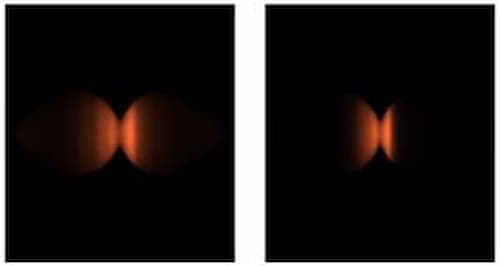
Astronomers tracking the constellation Ophiuchus have spotted a recurrent nova system (a transient astronomical event that causes the sudden appearance of a bright, apparently “new” star that slowly fades over weeks or months) approximately 5,000 light-years away.
Their study of data from the outburst of the star called RS Ophiuchi detected on August 8, 2021, which shows hot, central ionizing white dwarf with a constant luminosity but rapid temperature within the span of a month, may hold the key to understanding the formation of Type 1a supernovae. A Type Ia supernova is a rare type of supernova that occurs in binary systems (two stars orbiting one another) in which one of the stars is a white dwarf.
The star system RS Ophiuchi has shown recurrent eruptions since 1985. The latest has been in August 2021, when it reached a peak visual magnitude of 4.6 – bright enough to be seen with the naked eye. It is a binary system of a white dwarf star and a red giant, in which the latter supplies the white dwarf with fresh, hydrogen-rich fuel for nova eruption. With enough fuel, the material on the surface of the white dwarf achieves a critically high temperature and pressure, and a thermonuclear runaway (TNR) ensues, which lasts for about 1000 seconds. This explosion generates huge energy making the system visible from a far distance. Scientists have been looking for clues from the 2021 eruption to probe into this star system which has shown recurrent phases of becoming Nova—star that suddenly becomes much brighter for a short period.
The astrophysics team at S.N. Bose National Centre for Basic Sciences (SNCBS), an autonomous institute of the Department of Science and Technology (DST), acquired data from Astronomical Ring for Access to Spectroscopy Database (ARASD) to study the evolving spectra of the RS Ophiuchi Nova.
Dr. Ramkrishna Das, leader of the astrophysics team at the S.N. Bose Centre, found that with every eruption, the white dwarf accretes at least 10% of the ejected mass. They believe that eventually, it will explode as a Type 1a supernova. This event, if and when it occurs, will be the final proof of the conjecture around Type 1a supernova which states that if a white dwarf crosses the Chandrasekhar Limit of 1.4 Solar Mass, it collapses under its own gravitational pressure and gives birth to a Type Ia supernova.
This is because the electron degeneracy pressure in the core of the star is no longer sufficient to balance the gravitational pressure, leading to its collapse. The mass of the white dwarf in the RS Oph binary is estimated to be 1.2 to 1.38 solar mass. They carried out this study with the help of a model called 3D morpho kinematic model of the ejecta.
Their model indicates Helium to Hydrogen ratio increasing from 1.4 to 1.9 and Nitrogen to Hydrogen ratio increasing from 70 to 95. The Oxygen to Hydrogen ratio, as well as the Iron to Hydrogen ratio, increased substantially. The increasing abundance of the heavier elements indicates fusion reactions releasing energy. Nitrogen was found to be heavily overabundant in the ejecta. The ejected hydrogen shell mass of the system has been estimated to be in the range of 3.54 to 3.83 X 10-6 Solar mass.
Dr. Das informs that there are ten recurrent novae in the Milky Way Galaxy, but since 1988, there has not been a supernova explosion in the Milky Way. Perhaps the next explosion of RS Oph will take us closer to understanding the mechanism of the Type 1a supernova.
Follow on Facebook (https://www.facebook.com/industrialpunch) and Twitter (https://twitter.com/IndustrialPunch) for updates on social media…


















